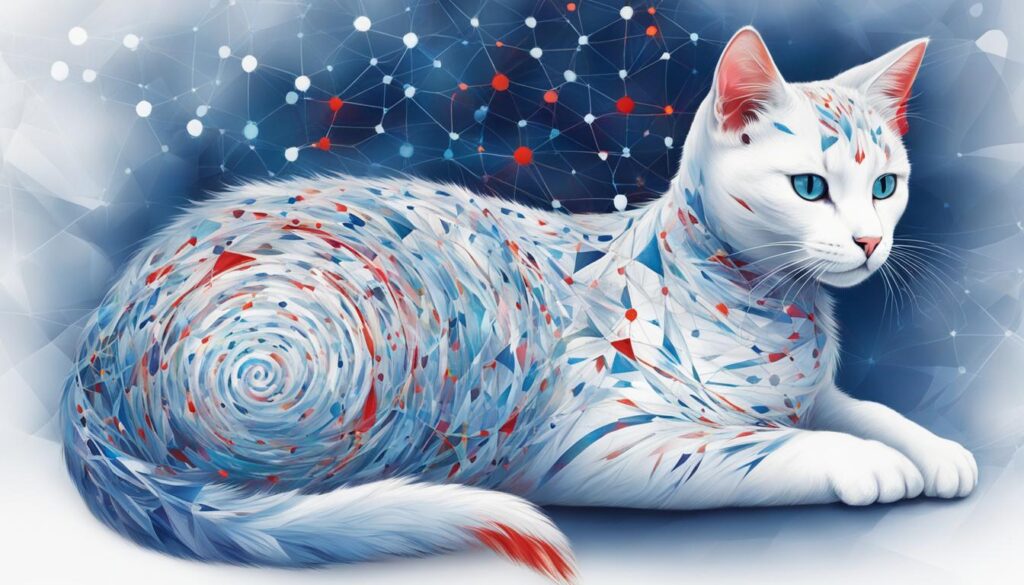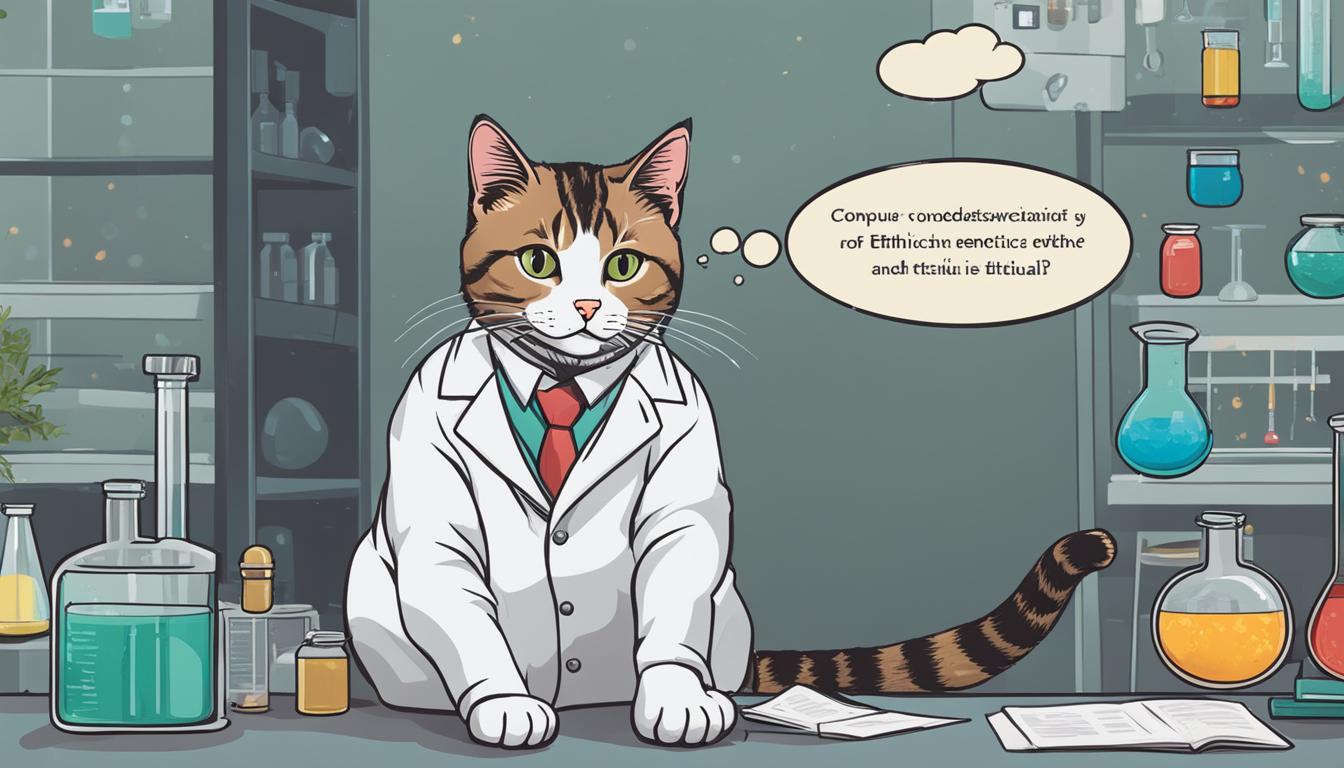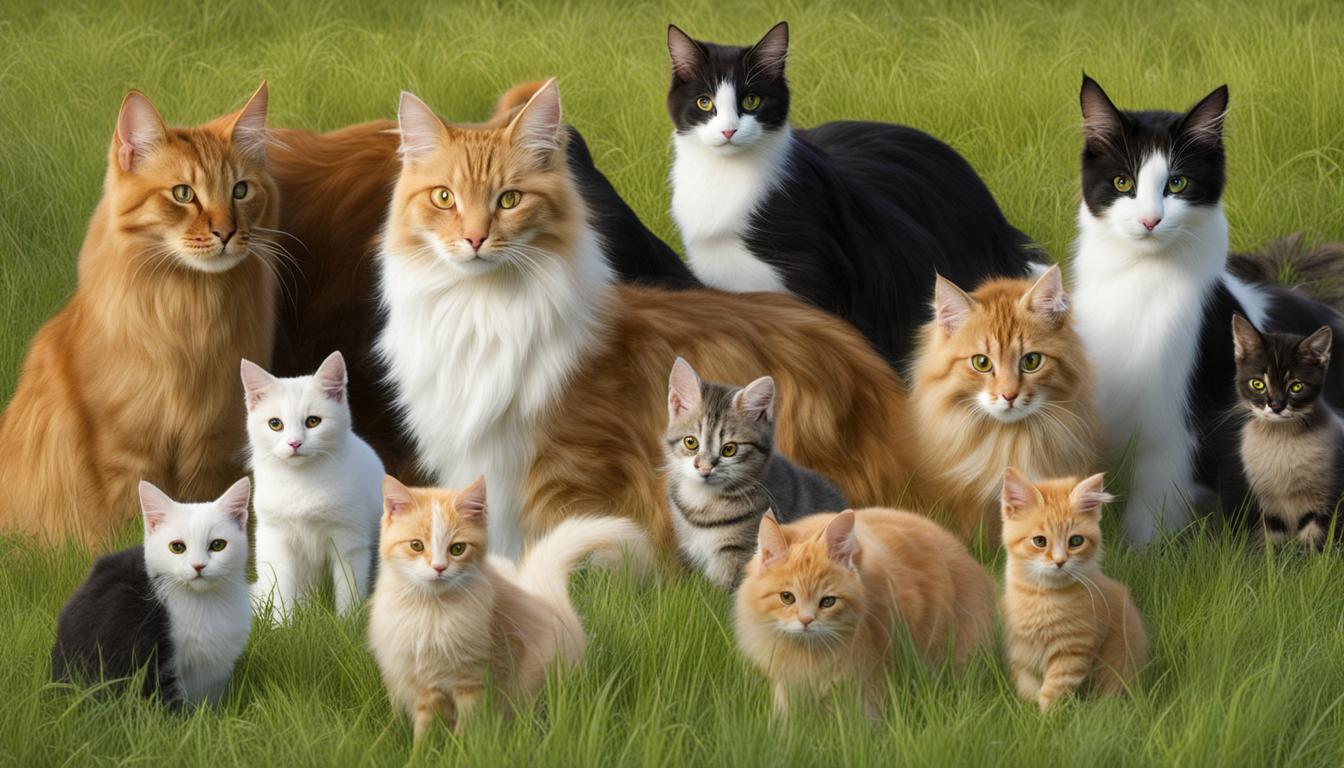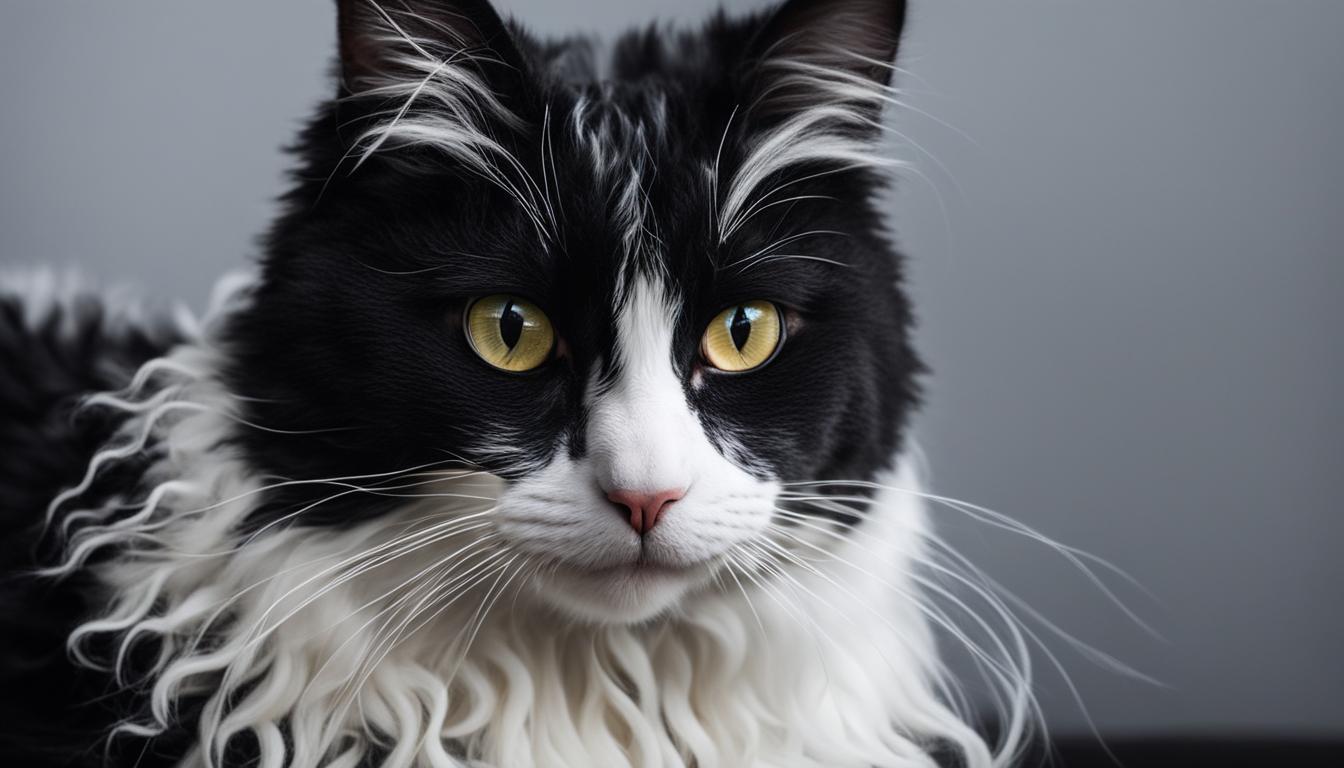Have you ever wondered why cats come in such a stunning array of coat colors and patterns? Well, I certainly have! As a curious cat enthusiast, I’ve delved into the fascinating world of feline coat color genetics to uncover the secrets behind our furry friends’ stunning appearances.
Understanding cat coat genetics is like unlocking a complex puzzle. It involves the interplay of various genes and genetic factors that determine the color, pattern, and even the presence of white markings on a cat’s coat. From the dominance and recessiveness of certain genes to the role of sex-linked genes, each aspect contributes to the unique beauty of our feline companions.
Key Takeaways:
- Feline coat color genetics involves a complex interplay of genes and genetic factors.
- Dominant and recessive genes determine the color and pattern of a cat’s fur.
- Sex-linked genes play a significant role in coat color inheritance.
- Calico cats have a distinct genetic makeup that results in their patchy coat pattern.
- The presence and extent of white markings on a cat’s coat are controlled by a separate gene.
The Basics of Cat Genetics: Chromosomes and Genes
Cat genetics is a fascinating field that explores the intricate world of chromosomes and genes. Understanding the basics of cat genetics is essential for unraveling the mysteries of feline coat color and pattern. Cats inherit 19 chromosomes from each parent, resulting in a total of 38 chromosomes. The sex of a cat is determined by the X and Y chromosomes, with females having XX and males having XY.
Genes on the X chromosome, known as sex-linked genes, can contribute to coat color variations in cats. These genes play a crucial role in determining the physical appearance of cats, including their fur color. Dominant and recessive genes also influence coat color genetics, with certain genes being more dominant than others.
White cats, on the other hand, have a unique genetic makeup that involves the white spotting gene. This gene is not related to coat color genes and determines the presence and extent of white markings on a cat’s coat. By delving into cat genetics, we can gain valuable insights into the fascinating world of coat color and pattern variations in our feline friends.

The Role of Chromosomes and Genes in Coat Color
The interplay between chromosomes and genes is crucial in determining a cat’s coat color. Genes located on the X chromosome can be dominant or recessive, contributing to different coat colors and patterns. The presence or absence of certain alleles can also result in unique coat variations. For example, the orange gene can be dominant, resulting in cats with orange fur, or recessive when paired with a black gene, resulting in cats with black fur.
In addition to the X chromosome, other genes play a role in coat color genetics. The dilute gene can lighten the color of a cat’s fur, while the dilute modifier gene can further lighten the dilute color. Tabby cats have a specific gene, known as the agouti gene, that produces striped or mottled patterns on their fur.
By understanding the basics of cat genetics, we can appreciate the complexity and beauty of coat color variations in our feline companions.
Unraveling the Colors and Patterns: Orange, Black, and Dilute Genes
When it comes to the colors and patterns of feline coats, genetics play a crucial role. Let’s dive into the fascinating world of orange, black, and dilute genes, and how they contribute to the stunning variety we see in cats.
At the core of feline coat color genetics are two primary colors: orange and black. These colors are determined by the orange gene (O) and the black gene (B), which can interact in various ways. The orange gene can be dominant, resulting in cats with vibrant orange fur. However, when paired with the black gene, it becomes recessive, giving cats a sleek black coat.
The dilute gene (d) is another factor that influences the color of a cat’s fur. It lightens the base color, resulting in shades such as cream and light gray. Additionally, the dilute modifier gene (Dm) further lightens the dilute color, creating even paler hues. These dilute genes contribute to the delicate pastel tones we often see in certain cat breeds.
The Tabby Cat Color Genes
Tabby cats, with their distinctive striped or mottled patterns, have their own set of color genes. The agouti gene determines the tabby pattern, influencing the distribution and intensity of the cat’s markings. This gene produces a variety of patterns, including classic tabby, mackerel tabby, and spotted tabby.
Did you know? Tabby cats are often referred to as “the working class” of feline genetics due to the prevalence of their coat pattern.
Understanding these genes that govern cat coat colors and patterns gives us a deeper appreciation for the mesmerizing diversity found in the feline world. From the fiery oranges and rich blacks to the soft pastels and intricate tabby patterns, each cat’s coat is a unique expression of its genetic makeup.
| Cat Coat Color | Genetic Factors | Description |
|---|---|---|
| Orange | O | Dominant gene resulting in orange fur |
| Black | B | Dominant gene resulting in black fur |
| Dilute | d | Lightens the base color, creating shades like cream and light gray |
| Dilute Modifier | Dm | Further lightens the dilute color |
| Tabby Pattern | Agouti gene | Produces striped or mottled patterns on a cat’s fur |
As we continue our exploration of feline coat color genetics, we’ll delve into the intriguing world of calico cats and the genetic factors behind their unique patterns.
The Genetics of Calico Cats and White Spotting
Calico cats are fascinating creatures with their distinct patches of orange, black, and white fur. Understanding the genetics behind calico cats provides us with insights into the complex interplay of genes that determine their unique coat patterns. The genetic mechanism behind the calico coat is closely tied to the X chromosomes and the phenomenon of X chromosome inactivation in female cats.
Female cats have two X chromosomes, while male cats have one X and one Y chromosome. During early embryonic development, one of the X chromosomes in female cats becomes randomly inactivated in each cell. This inactivation results in some cells expressing the orange gene (O) and others expressing the black gene (B), leading to the distinctive patchwork pattern seen in calico cats.
White spotting, on the other hand, is controlled by a different gene (S) that is not directly related to coat color genes. The S gene determines the presence and extent of white markings on a cat’s coat. Cats can exhibit various degrees of white spotting, ranging from no white markings to partial or almost completely white coats. The genetics of white spotting is a separate factor from coat color genetics, adding another layer of complexity to the diverse coat patterns we see in cats.
| Coat Color | Genotype | Phenotype |
|---|---|---|
| Calico | Female: XOXb Male: XOY or XbY |
Patches of orange, black, and white fur |
| Tortoiseshell | Female: XOXb Male: XbY |
Patches of orange and black fur, no white |
| Bi-color | Dependent on white spotting gene (S) | Color patches with white markings |
Through a deeper understanding of calico cat genetics and the role of white spotting, we can appreciate the intricate genetic processes that result in the beautiful coat patterns we observe in cats. The complex interplay of genes and chromosomes gives each cat a unique expression of their genetic makeup, showcasing the astonishing diversity of feline coat colors and patterns.
Conclusion
The world of feline coat color genetics is a fascinating one, filled with intricate details and surprising discoveries. As I delved into the subject, it became clear that genetic factors play a crucial role in shaping the coat patterns of our beloved cats. From tortoiseshell cats to those with extensive white markings, the diversity is truly remarkable.
Understanding the genetic factors involved in cat coat patterns allows us to appreciate the complexity of their genetics. Whether it’s the dominance and recessiveness of certain genes or the interplay of sex-linked genes, each cat’s coat is a unique expression of its genetic makeup. It’s like a work of art painted by the hand of nature.
Tortoiseshell cat genetics, in particular, are mesmerizing. The patchwork of orange and black fur is a result of the inactivation of one of the X chromosomes in female cats. This intricate dance of genes and chromosomes creates a stunning display of colors that never ceases to amaze.
And let’s not forget about the genetics of white cats. The presence and extent of white spotting on their coats are determined by a separate gene, not related to coat color genes. This genetic factor adds an extra layer of complexity to the already captivating world of feline coat patterns.
So, the next time you gaze upon your cat’s beautiful coat, take a moment to appreciate the hidden world of genetics that created it. The genetic factors at play in cat coat patterns are like pieces of a puzzle, coming together to form a masterpiece. Truly, our feline friends are walking works of art.
FAQ
How do cats inherit their coat color?
Cats inherit their coat color from their parents. Genes on the X and Y chromosomes play a significant role in determining coat color.
What determines the dominance and recessiveness of genes in cats?
The dominance and recessiveness of genes determine the color and pattern of a cat’s fur.
Are there specific genes involved in the development of fur patterns in cats?
Yes, researchers have discovered specific genes, like DKK4, that are involved in the development of fur patterns in cats.
How many chromosomes do cats inherit?
Cats inherit 19 chromosomes from each parent, totaling 38.
How is the sex of a cat determined?
The sex of a cat is determined by the X and Y chromosomes. Females have XX and males have XY.
What genes are responsible for white spotting in cats?
The white spotting gene (S) determines the presence and extent of white markings on a cat’s coat.
What are the base colors of feline coats?
The base colors of feline coats are orange and black, which are determined by the orange gene (O) and the black gene (B).
How do dilute genes impact a cat’s fur color?
The dilute gene (d) can lighten the color of a cat’s fur, while the dilute modifier gene (Dm) can further lighten the dilute color.
What gene produces striped or mottled patterns on a cat’s fur?
The agouti gene produces striped or mottled patterns on a cat’s fur, commonly seen in tabby cats.
How do calico cats get their distinct patches of fur?
Calico cats have distinct patches of orange, black, and white fur due to the interplay of the X chromosomes and the inactivation of one X chromosome in female cats.
Is the white spotting gene related to coat color genes?
No, the white spotting gene (S) is not related to coat color genes. It determines the presence and extent of white markings on a cat’s coat.





